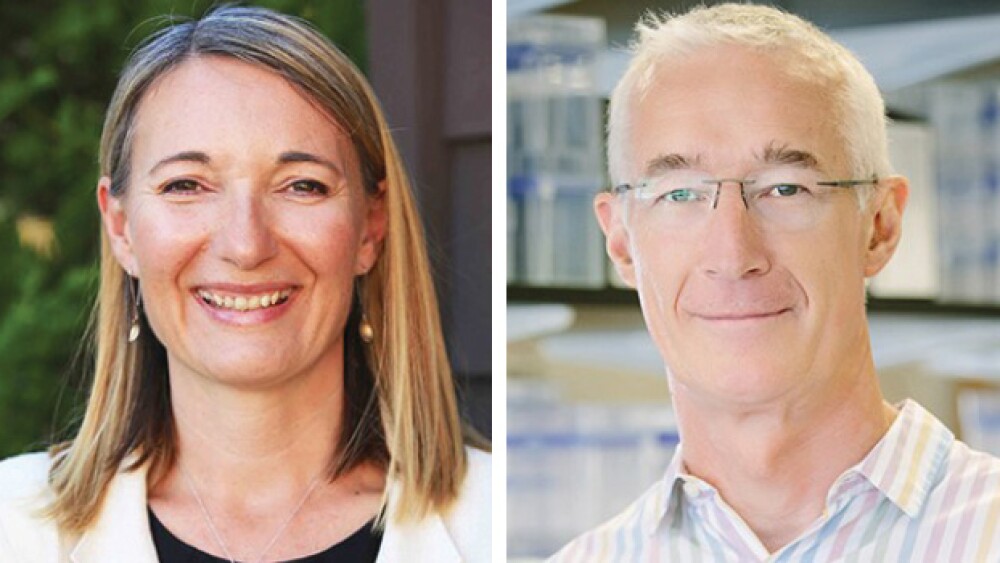Industry leaders say the second generation of interventions for nonalcoholic steatohepatitis is likely to succeed where first-generation approaches stumbled.
Kitty Yale and Tim Rolph, Akero Therapeutics/courtesy of Akero Therapeutics
Clinical trials for nonalcoholic steatohepatitis (NASH) therapies are returning positive data. Industry leaders say this generation of interventions is likely to succeed where first-generation approaches stumbled, thanks to novel approaches and a greater understanding of the disease.
In December, Madrigal Pharmaceuticals announced much-anticipated positive results from the pivotal trial of resmetirom. Madrigal’s shares soared in response to the data, reflecting the lucrative opportunity for the first NASH therapy to hit the market.
But Madrigal is not the only contender getting close in this space.
Akero Targets Phase III in 2H ’23
Akero Therapeutics’ efruxifermin (EFX), currently in Phase II trials, works beyond just NASH to regulate additional metabolic pathways and cellular processes.
“It not only improves [the] metabolic health of the liver but also appears to act directly to inhibit deposition of fibrotic tissue in the liver,” said Tim Rolph, CSO and co-founder of Akero, in an interview with BioSpace.
A reduction in fibrosis (scarring of the liver) of approximately 40% occurred within six months, as well as a reduction in inflammation, Rolph said. With gastric bypass surgery, it takes longer than a year to achieve such a reduction in fibrosis and 4-5 years to resolve fibrosis in the majority of patients, absent a direct antifibrotic effect, he added.
EFX mimics the biological activity of fibroblast growth factor 21. Therefore, it reduces fat in the liver as well as in the adipose tissue, both of which cause liver disease.
Initially, Akero’s team thought the results were too good to be true, but they have been validated in four different studies with consistent results.
“What is unique is how well the molecule is connected to the receptors and which receptors it binds with,” said Kitty Yale, chief development officer. “It’s a level of efficacy that hasn’t been seen with other molecules.”
Yale said Akero plans to launch Phase III trials in the second half of 2023.
Hepion to Leverage AI in Longer Trial
Hepion Pharma’s NASH program is also being assessed in two Phase II trials. One four-month trial studies liver function using the HepQuant blood test and the other is a year-long biopsy-controlled study. A Phase III trial is anticipated in early 2025.
The investigational drug is an oral, once-daily therapy that addresses the collagen deposition that leads to fibrosis.
Trial data showed elevated liver enzymes and other indicators of collagen synthesis (which produced fibrosis) dropped to near-normal levels in six months, said Robert Foster, Pharm.D., Ph.D., CEO of Hepion.
In a longer trial that is being planned, “We’ll look at those things, but also [at] the patients’ genes to see if we can normalize gene regulation,” Foster told BioSpace. Hepion will also look at lipids, proteins and metabolites.
This approach may enable the therapy to address liver disease from the mild to severe stages, Foster said.
Because the studies involve hundreds of thousands of data points, artificial intelligence algorithms will be used for the analysis and to guide the company through later-stage clinical trials.
“Companies are moving closer to the point where they can get a drug approved, but there’s a lot to understand,” Foster said. “As the disease progresses, the goalposts are always moving. We’re trying to figure out what’s moving them and how drug treatments affect that.”
Chemomab Targets CCL24
Chemomab Therapeutics is developing a monoclonal antibody to neutralize one of the drivers of inflammation and fibrosis.
“What makes our approach distinctive is that our novel CCL24 target is a soluble mediator of both inflammation and fibrosis and is closely involved in the pathophysiology of a wide range of diseases where there is chronic immune-driven inflammation resulting in fibrosis,” said Mitch Jones, M.D., Ph.D., VP, corporate development and strategy at Chemomab.
A Phase IIa trial showed improvements in several biomarkers related to liver fibrosis. Nearly 60% of patients showed improvements in at least three biomarkers at week 20, versus none in the control group. Liver elasticity also improved.
“There are many therapies in development targeting metabolic function, but few with disease-modifying anti-fibrotic efficacy or potential,” Jones said.
The Second Generation
The leading second-generation NASH therapies have disease-modifying potential.
“NASH drug development remains one of the few races in drug development,” said Mark W. Tengowski, DVM, Ph.D., scientific director, musculoskeletal medical affairs at Clario, a clinical trial technology company.
“What makes NASH development different (from the era of statins) is the variety of mechanisms that can alter liver fat. In addition to pharmacology, there’s a genetics component.”
Therefore, NASH therapy developers have several possible avenues to explore.
Looking to the near future, drug combinations are likely, each of these researchers said. That includes drugs that target multiple metabolic and fibrotic pathways and that work at multiple stages of the disease. The prospect of gene or cell therapy was also raised as a possible future treatment.






